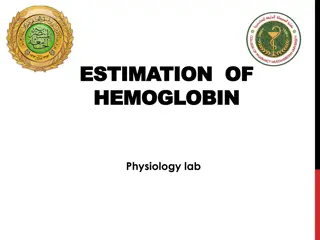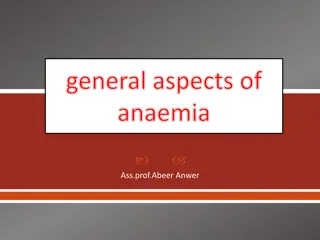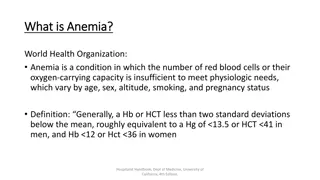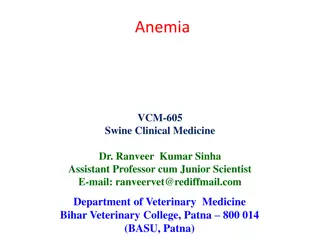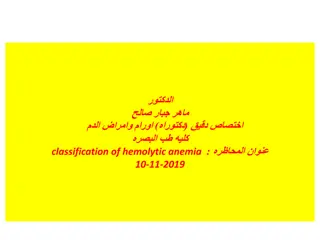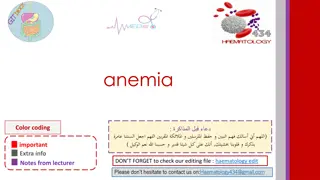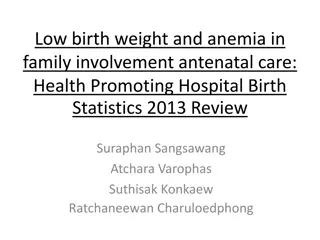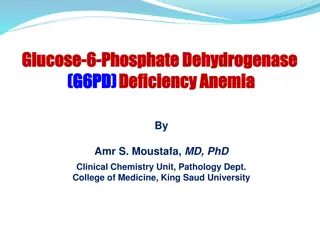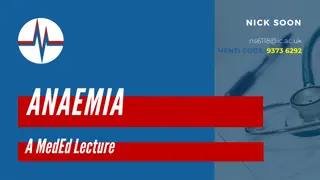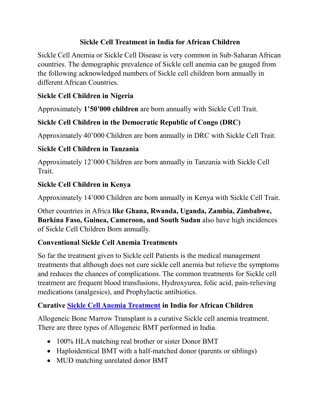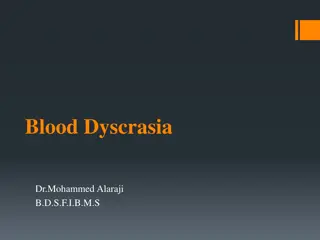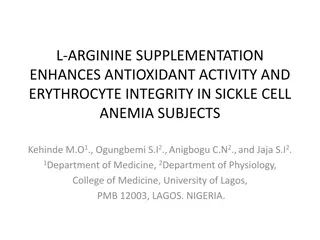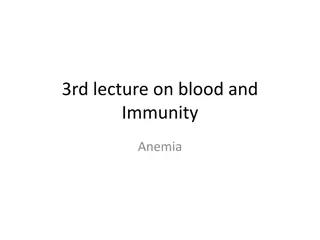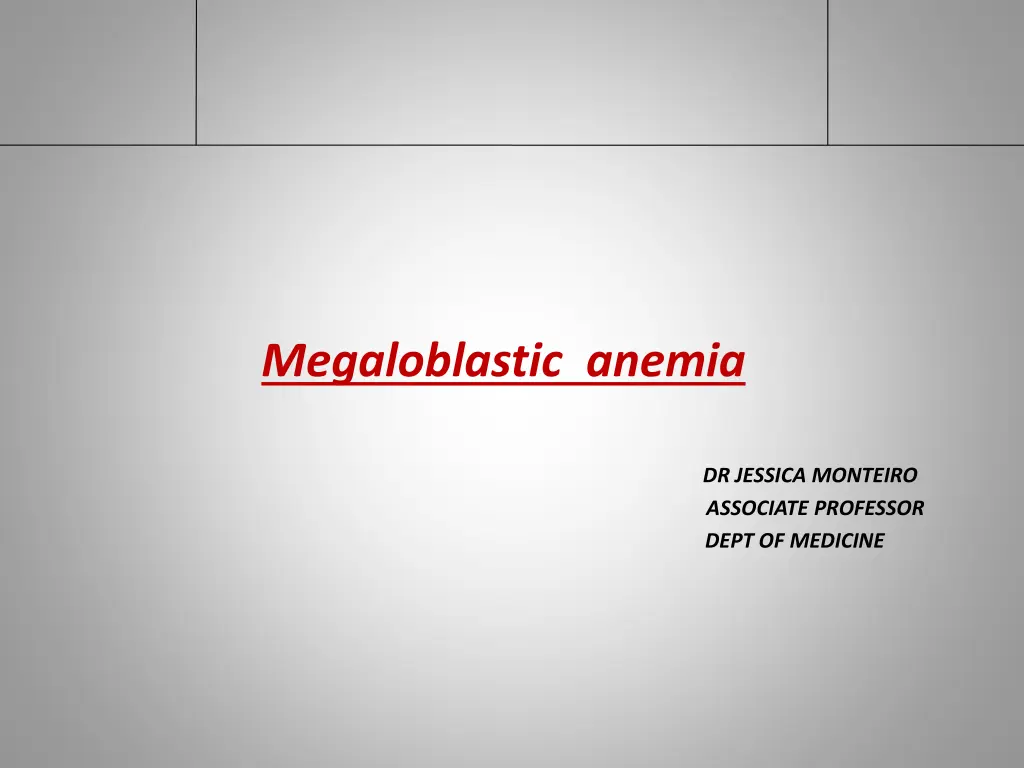
Understanding Megaloblastic Anemia and Its Implications
"Megaloblastic anemia, a condition caused by deficiencies in vitamin B12 or folic acid, leads to macroovalocytic red blood cells. Dr. Jessica Monteiro, an associate professor in the Department of Medicine, explains the intricacies of this condition, including its symptoms, causes, and treatment options. Explore the relationship between vitamin B12, DNA synthesis, and the importance of proper nutrition in managing this type of anemia."
Download Presentation

Please find below an Image/Link to download the presentation.
The content on the website is provided AS IS for your information and personal use only. It may not be sold, licensed, or shared on other websites without obtaining consent from the author. If you encounter any issues during the download, it is possible that the publisher has removed the file from their server.
You are allowed to download the files provided on this website for personal or commercial use, subject to the condition that they are used lawfully. All files are the property of their respective owners.
The content on the website is provided AS IS for your information and personal use only. It may not be sold, licensed, or shared on other websites without obtaining consent from the author.
E N D
Presentation Transcript
Megaloblastic anemia DR JESSICA MONTEIRO ASSOCIATE PROFESSOR DEPT OF MEDICINE
It is a type of anemia caused by impaired DNA synthesis due to deficiencies of vit B12 or folic acid which gives rise to macro ovalocytic red cells .
Vit B 12 Meat and dairy products only Minimum daily requirement 6-9 mcg/d Total body store 2-5 mg (half in liver) Helps to synthesize thiamine, thus deficiency leads to problems with DNA replication
Initially bound to protein in diet, liberated by acid and pepsin, then binds to R factors in saliva and gastric acids Freed from R factors by pancreatic proteases them binds to Intrinsic Factor secreted by gastric parietal cells Absorbed together (Cbl + IF) in ileum Released from IF in ileal cell then exocytosed bound to trans-Cbl II Cbl bound to transcobalamin II binds to cell surface receptors and is endocytosed
Atrophic glossitis (shiny tongue) Shuffling broad gait Personality changes Hyperhomocysteinemia Neurologic symptoms (next slide) Copper deficiency can cause similar neurologic symptoms
Neurological symptoms Paresthesias Memory loss Numbness Weakness Loss of dexterity due to loss of vibration and position sense Symmetric neuropathy legs>arms Severe weakness, spasticity, clonus, paraplegia and incontinence
Subacute combined degeneration of the dorsal (posterior) and lateral spinal columns Due to a defect in myelination Degeneration and demyelination of the dorsal (posterior) and lateral spinal columns
Macroovalocytic anemia with elevated serum bili Increased red cell breakdown due to ineffective hematopoiesis WBC & platelets normal to low Hypersegmented neurophils
Hypercellular marrow Megaloblastic erythroid hyperplasia Giant metamyelocytes Due to slowing of DNA synthesis and delayed nuclear maturation Methionine deficiency may play a central role
Folic acid Animal products (liver), yeast and leafy vegetables Normal requirement 400mcg/day Pregnancy/Lactation: 500-800mcg/day Increased requirement in hemolytic anemia and exfoliateive skin disease Body stores: 5-10mg
Folate at physiolofical level enters the cells by binding to folate receptor. Once inside the cell FA is polyglutamated , a form which is biologically active and cannot diffuse back into the plasma
Causes Malnutrition: Destroyed by heat during cooking Alcoholism (decreased in 2-4 days): impairs enterohepatic cycle and inhibits absorption Increased requirement in hemolytic anemia, pregnancy, exfoliative skin disease IBD, celiac sprue Drugs Trimethoprim, Methotrexate, Primethamine (inhib DHFR) Phenytoin: blocks FA absorption, increases utilization (mech unknown)
C/F Similar symptoms as B12 but neurologic abnormalities do not occur Presentation is classically seen in: Alcoholic pts Very poor dietary intake Older Depressed Living alone
Hyperhomocysteinaemia Both CBL and FA are required for the metabolism of homocysteine to methionine. As a result , deficiencies in these vitamins can lead to elevation in the plasma homocysteine levels which is a risk factor for the development of atherosclerosis and venous thrombosis
Shillings test 1. PART 1: Oral labeled B12 and IM unlabeled B12 at the same time to saturate tissue stores 2. 24h urine to assess absorption >5% normal <5% impaired 3. PART 2: Repeat w/oral IF if now normal =PA if abnormal = malabsorption

